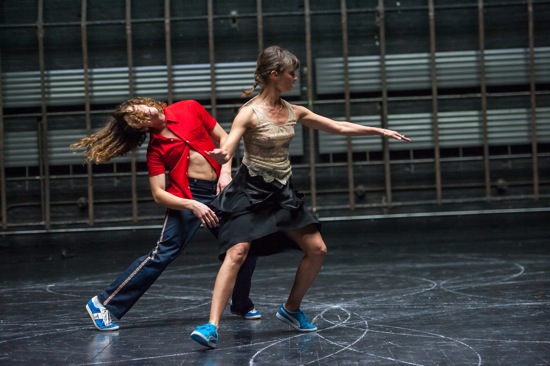Anne Teresa De Keersmaeker’s Rosas and graindelavoix perform in En Atendant and Cesena.
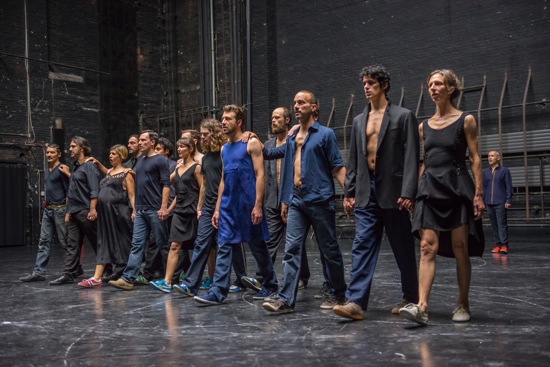
Members of Rosas and graindelavoix walk together in Anne Teresa De Keersmaeker’s Cesena. Photo: Stephanie Berger
I wish that I had been in Avignon in July of 2010. Then I could have seen Anne Teresa De Keersmaeker’s En Atendant performed in the ancient Cloister of the Celestines, and, a week later, her companion piece, Cesena, in the Court of Honor, an amphitheater attached to the Papal Palace. Both were performed in natural light—the first as dusk deepened into night; the second as the dark early morning hours gradually yielded to dawn. There would have been birds and winds and distant sounds from a slumbering city.
Moreover, the two astonishing works would have been cloaked in the history of the French city. The music for both pieces dates from the late 14th century—a time when the plague killed thousands, and men were constantly riding into battle, or seeking to rape and pillage. Too, some of the songs from the Codex Chantilly that accompany Cesena have connections to the papal schism of 1378, which resulted in a pope in Avignon (where one had been quartered for some 70 years) and one back in the papacy’s original site: Rome. The Avignon pope installed at the time, Clement VII, was the cardinal who had previously ordered the slaughter of every man, woman, and child in the village of Cesena, just to show what happened to people who questioned the authority of the church.
De Keersmaeker’s En Atendant and Cesena, however, were astonishing enough on the Brooklyn Academy stage, with theatrical lighting conveying the passage of time, plus a slender band of sand across the stage to remind us of En Atendant’s outdoor origin and a circle of sand for Cesena. Audiences could see the first at 2:00 P.M. and/or the second at 7:30. Many people elected to see both on the same day.
These two pieces reveal what has been a constant in De Keersmaeker’s work: a poetic and expressive use of form. Roses danst Rosas (1983), one of the earliest works that her Belgium-based company performed here, was sometimes mentioned in relation to minimalism. But her choice of the simple moves and gestures performed by four women in carefully restricted space rendered the dance anything but minimal. Like Rosas, the fastidiously structured works she has created since then resonate with human feeling, despite the absence of any through-composed narrative. She has remarked that she doesn’t view dancers as inert, malleable materials, but rather as people who reveal their humanity in every move they make.
The process that De Keersmaeker and her dancers have gone through to create these two works—along with the collaborating musical director Björn Schmelzer and the seven singers who move with the dancers in Cesena—is one that digs deep into the music’s structures; into resonant spatial symbols, such as interlocking circles and a pentagon within a circle; into mathematics (the Fibonaci numbers, for example); into the I-Ching, into architectural principles; into history; and more. Unless you have delved into En Atendant & Cesena: A Choreographer’s Score, by De Keersmaeker and Bojana Cveljić (distributed by Yale University Press), you would not know all the details that gave birth to her choreographic ideas.
However—and this is difficult to explain—you nevertheless have a sense of deep matters shaping what you see—elements that you needn’t try to identify. The integral structures, so subtly alluded to in the dances, hold everything together and keep you alert. Both pieces shimmer with mysteries veiled, re-purposed, and dissected; watching the performances is like peering in a deep well; you intimate the water that seeps into it, imagine the faces it has reflected, and fear to think what may lie at its bottom.

(L to R) Carlos Garbin, Mark Lorimer, Chrysa Parkinson, Sue-Yeon Youn, and Sandy Williams in En Atendant. Photo: Stephanie Berger
You can be happily surprised when Mikael Marklund’s sudden burst of leaps in En Atendant roils a quiet moment; you needn’t know that he is temporarily personifying the gush of the fountain being sung of, being longed for. Also in En Atendant, Bošjian Antončič explodes into a remarkable, apparently unprovoked fit— vigorously slashing the air, twisting and turning, striking, recoiling. While others onstage stare, he calms down, then jolts into solitary battle again. The startled viewer will not know that Antončič, along with each of the seven other dancers in En Atendant, has internalized a brief description (provided by performer Chrysa Parkinson) of characters associated with the music’s own history, a number of them members of the powerful Visconti family. Antončič’s assumed persona was defined as “greedy, crafty, cruel and ferocious, given to paroxysms of rage and macabre humor,” and noted that “had a sense of formalized violence” was pent up inside him.”
Likewise, you will not understand why Carlos Garbin prowls around in the background, watching Antončič (and I will not tell you); the enigmatic tension between the two men is enough. And you will come to see that watchfulness is characteristic of the worlds shown in both dances. The performers are always staring at what is happening, making decisions, repositioning themselves, and looking at events from a new angle. The song “En Atendant” is heard three times in the course of the dance of that name. Waiting for what? For death to come, whether from the plague or from the sword? For a lover to return, or love to blossom? For those in exile from Rome serving the antipope? All of these, surely, and more.
De Keersmaeker also shows images of death or illness. These are very formally presented; dancers simply lie down, facing the ground or supine, and lie there for a few seconds or longer. There’s a moment in Cesena when Parkinson is prone, and Aron Blom kneels beside her, singing verses called “Corps femenin.” The words praise the body of a child queen dead at ten years old; Blom gently rearranges Parkinson’s head and limbs in small ways, making them “dance” again.
En Atendant begins with an uncanny musical prelude. Michael Schmid advances to the front of the stage, where he slowly, ceremoniously raises the flute he is carrying and begins to play. No, not at first playing, simply breathing. Finally a high, thin note emerges, then a soft, deeper one joins it. The high note never stops; the low, intermittent one becomes growly or flutters. Schmid, practicing circular breathing, doesn’t sway his body the way some flautists do; he stands almost motionless. I say “almost” because, at times, his white shirt palpitates as if stirred by a rapid, delicate panting. Seldom has breath been so directly offered as a subject in a dance.
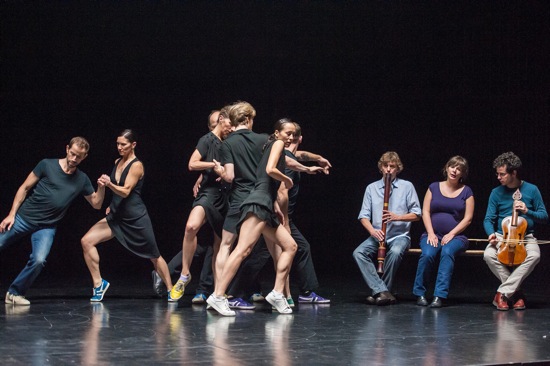
(L to R): Mark Lorimer, Cynthia Loemij, Carlos Garbin, Chrysa Parkinson, Mikael Marklund, Sue-Yeon Youn, Sandy Williams, Bart Coen, Annelies Van Gramberen, and Thomas Baeté in En Atendant. Photo: Stephanie Berger
The music that impels and accompanies En Atendant is performed by the ensemble Cour et Coeur: its music director and recorder player, Bart Coen; Thomas Baeté, who performs on the antique fiddle known as a vielle; and Annelies Van Gramberen, she of the crystal-clear soprano, undisturbed by vibrato. When the black-clad dancers (costumes by Anne-Catherine Kunz) walk from one side of the stage to the other and back again a number of times, there’s a logic you can’t quite fathom. Individuals gradually join the group to step at a measured pace, sometimes pausing at various times. With the musicians silent, you can see that there are three walking patterns, which the music later brings out. (It turns out that subgroups have been walking the rhythms, phrase shapes, and durations of three differently pitched strands in the music: the conductus (low), the contratenor (high), and the tenor (between the two). Once the musicians join, the dancers’ contrapuntal patterns in relation to those three elements become more complex, their steps more strenuous, their pace swifter. People touch one another, form chains, appear to consult.
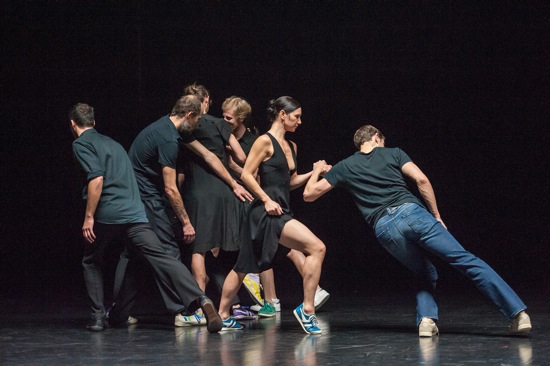
(L to R): Mark Lorimer, Carlos Garbin, Chrysa Parkinson, Mikael Marklund, Cynthia Loemij, and Sandy Williams in En Atendant. Photo: Stephanie Berger
What you see in all this is a community that wavers between decision and indecision—one that tries different strategies within limits and may be concerned about external forces. Sometimes you discern the structures. Early in En Atendant, Parkinson performs a solo in silence; she explores its changes of direction, dynamics, and body designs with an everyday energy and a certain care, as if these sophisticated moves were a familiar household task. You find that you recognize elements of this solo when they appear later, performed by other dancers, perhaps in differing order, perhaps in retrograde.
Much remains enigmatic. Sandy Williams crashes to the floor from a jump. Sue-Yeon Youn dances in a gentle questioning manner, shifting her gaze in different directions, and whenever she wants to sink into a squat, Parkinson and then Cynthia Loemij take her hand to steady her, but their touch is extremely light, as if she were too fragile to be grasped. Occasionally one person whispers a secret to another. In one sequence, the performers create tableaux and hold their poses for a few seconds; these images have the air of stills from a cinematic battlefield. The performers also begin to alter their attire—adding or removing various items of clothing, or exchanging them for others. Mark Lorimer sheds his jeans and Loemij puts them on.
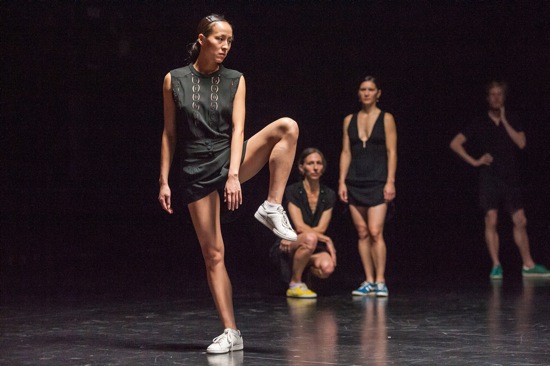
Sue-Yeon Youn in En Atendant, watched by Chrysa Parkinson, Cynthia Loemij, Mikael Marklund and Sandy Williams. Photo: Stephanie Berger
It takes a while to realize that a major element of the lighting and Michel François’ design, a suspended panel of lights, is gradually eliminating the small lamps two by two. By the time Lorimer performs the final solo, the stage is quite dark, but he is naked, and, especially when he dances in the foreground, his pale body seems luminescent. He keeps disappearing into blackness at the back of the space, and then re-appearing. Finally it’s too dark to see him.
I haven’t said how remarkable the performers are—both in executing choreographed sequences and in improvising on them. Their skills become even more varied in Cesena, as do those of the additional dancers and the singers who join them to make a cast of 19. In this part of the diptych, the music is all vocal, belonging to the style termed ars subtilior, the refinement of ars nova that flourished between 1470 and 1490. The seven singers are members of graindelavoix, the ensemble directed by Schmeltzer. They move with the dancers, and the dancers sing with them. Many of the ravishing musical selections are four-part motets, and, like many motets may incorporate two diverse texts—in the case of Cesena, mingling religious ones with political ones.
En Atendant ends in darkness with a naked man alone on stage. Cesena begins in darkness, again with a naked man the only person there, and barely visible. But this man (it is Marklund) also refers back to Schmid’s flute playing at the beginning of En Atendant. He is not singing as much as he is yelling, albeit in controlled rhythms, and he is not motionless, as Schmid was. Between gusts of calling out on long notes (you imagine him a watchman alerting the town to coming danger or a Greek messenger recounting the horrors he has seen), he bends over to take a breath, and whistling sounds mix with his voice.
Running around the circle of sand inscribed in the middle of the stage floor, he, like Lorimer before him, shines in the darkness, The sounds of his galloping feet as he exits are echoed by unseen members of the cast. They gradually—dimly— appear in a horizontal line as they walk forward. Holding on to one another to keep the same rhythm, they turn and retreat, turn and come forward again. As they continue this pattern, Marklund hits a stick against something at the side to create a pulse (and to refer to workmen building), and the performers begin to sing the first motet “ Pictagore per dogmata/O Terra supplica,” with three singers taking the cantus and contratenor lines, while the others sing and walk with the tenor one. As the music ends, we begin to hear more whistling and feet brushing the floor.
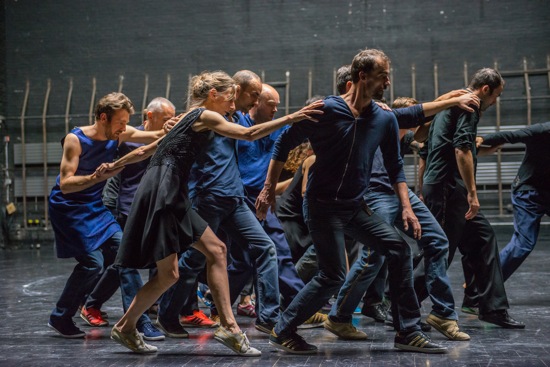
Anne Teresa De Keersmaeker’s Cesena. Foreground: Chrysa Parkinson and Matej Kejžar. Photo: Stephanie Berger
The dawn seems very slow in coming. It takes a while to discern that all the performers are men, with the exception of Parkinson, Marie Goudot, and singer Olalla Alemán. They could be soldiers on the march, monks, who knows? Williams, hurling himself around, begins to scatter the sand in the circle; its outline will become blurrier as Cesena progresses.
The contrapuntal patterns that we see and hear create, in their own ways, images of resistance, destruction, rebuilding, injury, rescue, and death. As people move closer together, they touch, push, pull, and support one another. The very title aligns this work with the demolishing of Cesena and its citizenry, along with the role played in that action by the pope-in-waiting. We see, too, what might be illness or drunkenness; at one point, Albert Riera drags himself along as if crippled. At another, some people cluster and, holding on to one another, sneak along, bent over and walking on tiptoe. A hoped-for escape?
There’s a wonderful sequence in which Parkinson and Goudot, joined by several others, including Alemán singing “En attendant d’amer,” begin a phrase by Parkinson that incorporates gestures seen in En Atendant (one involves the performers crossing their arms to bury their hands in their armpits—soldiers hiding the black spots of the plague). The light is brightening, and in imitation of the mirror that was positioned on a rooftop in Avignon, smaller mirrors reflect light onto the faces of Parkinson and Goudot, so that they appear transfigured by the thought of love.
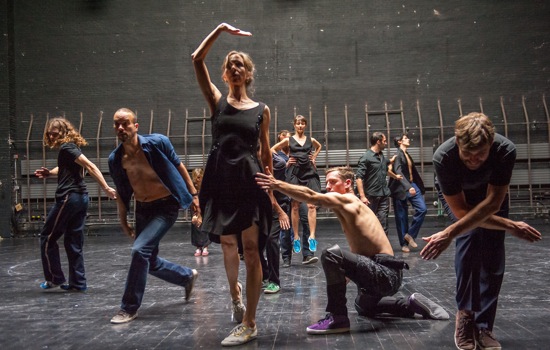
(Foreground, L to R): Aron Bolm, David Hernandez, Chrysa Parkinson, Sandy Williams, and Marius Peterson in Cesena. Photo: Stephanie Berger
During this two-hour spectacle, I wished again that I had been among the 2000 witnessing Cesena in Avignon. Sitting there, I could have looked up and seen the sky turning to lavender to pink to blue and heard birds beginning to stir. The spectators at BAM who became restless during the long, dark beginning would have been able to peer into shadows where 14th-century people hid or exchanged secrets, and imagine this time of disasters. They could have likened the sun’s gradual ascent to the slow dawn of the Renaissance.
Cesena gives rise to another thought. De Keersmaeker is bringing to life in her own way an historical religious schism, the events and feelings associated with it, and the music of the time. At one point, the mingled ensemble of 12 dancers and seven singers separate in half and draw apart. Albert Riera on one side of the stage and Garbin on the other conduct the singing from within their groups. Rome faces Avignon. Sometimes, schisms even occur within the performers’ bodies—their feet walking one musical part while they chant another.
Yet over the course of the piece, singers travel, tangle, and collapse with the dancers, and dancers join their voices with those of the singers. Matej Kejžar stops dancing for a moment and roughens his voice to sing—alone— a Slavic folk song. So it’s not just a new day dawning and, by analogy, the eventual end to the Avignon papacy that De Keersmaeker suggests in Cesena. The musicians and dancers, working together, have built a joint structure and, in so doing, heal any schisms that one may have thought to exist between their two born-together artistic disciplines.

